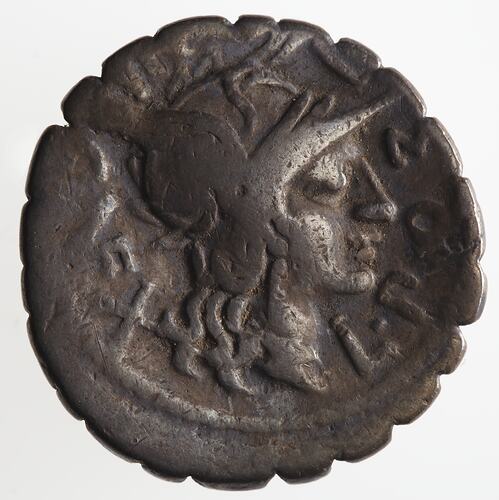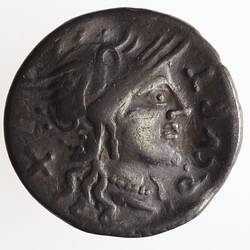Summary
Denarius, Issued by Ancient Roman Republic, 118 BC
Moneyer: L. LIC. (L. Licinius), CN. DOM. (Cn. Domitius) and L. Pomponius
Minted in Narbo (Colonia Narbo Martius, now Narbonne, France)
Note: this is a denarius serratus
Obverse Description
Helmeted head of Roma facing right; behind, the denomination mark, X; around, L. POM [PONI] CNF
Reverse Description
Gallic warrior in a biga drawn by horses to right, the warrior holds a shield and carnyx in his left hand and is in the act of hurling a spear with his right; in exergue, L. LIC. CN DOM
Edge Description
Serrated
Significance
This issue is associated with the foundation of the Roman Colony known as Narbo Martius in 118 BC. The names on the reverse, L. LIC. (L. Licinius Crassus) and CN. DOM. (Cn. Domitius Ahenobarbus), are believed to be the founding duoviri of the Colony. The name on the obverse is that of one of the five special moneyers who were responsible for this unusual coinage. The practice of notching the edge of the coin with a chisel prior to striking is not unique to the issues from Narbo (though all Narbo coins are serrated). It's purpose is uncertain, if it was to stop forgery it failed as serrated forged coins are well known. Tacitus (Germanica 5.5) records that the serratus style was popular with Germans, perhaps the Gauls liked them too.
More Information
-
Collection Names
-
Collecting Areas
-
Acquisition Information
Transfer from National Gallery of Victoria (NGV), 15 Mar 1976
-
Date Issued
118 BC
-
Issued By
-
Mint
-
Denomination
-
Material
Silver
-
Axis
12
-
Classification
-
Category
-
Discipline
-
Type of item
-
Dimensions
19 mm (Outside Diameter), 3.792 g (Weight)
-
Shape
Round
-
References
Crawford 282/4 McMasters University, Brace Coin Collection [Link 1]
[Book] Crawford, Michael H. 1974. Roman Republican Coinage., 71-75, 298-299 Pages
[Book] Melville Jones, John. 1990. A Dictionary of Ancient Roman Coins., 286-287 Pages
[Catalogue] Pullin, Ruth. 2011. Nature Revealed: Eugene von Guerard.





